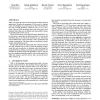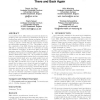EDBT
2004
ACM
15 years 6 months ago
2004
ACM
Abstract. As XML schemas evolve over time or as applications are integrated, it is sometimes necessary to validate an XML document known to conform to one schema with respect to an...
PODS
2005
ACM
15 years 6 months ago
2005
ACM
We consider here the exchange of Active XML (AXML) data, i.e., XML documents where some of the data is given explicitly while other parts are given only intensionally as calls to ...
SIGMOD
2003
ACM
15 years 6 months ago
2003
ACM
XML is becoming the universal format for data exchange between applications. Recently, the emergence of Web services as standard means of publishing and accessing data on the Web ...
133
click to vote
SIGMOD
2009
ACM
15 years 6 months ago
2009
ACM
Whether beloved or despised, XML Schema is momentarily the only industrially accepted schema language for XML and is unlikely to become obsolete any time soon. Nevertheless, many ...
113
click to vote
POPL
2003
ACM
15 years 6 months ago
2003
ACM
The World-Wide Web Consortium (W3C) promotes XML and related standards, including XML Schema, XQuery, and XPath. This paper describes a formalization XML Schema. A formal semantic...
WWW
2001
ACM
15 years 6 months ago
2001
ACM
MSL (Model Schema Language) is an attempt to formalize some of the core idea in XML Schema. The benefits of a formal description is that it is both concise and precise. MSL has al...
WWW
2003
ACM
15 years 6 months ago
2003
ACM
XML Schema is a rather complex schema language, partly because of its inherent complexity, and partly because of its XML syntax. In an effort to reduce the syntactic verboseness a...
WWW
2003
ACM
15 years 6 months ago
2003
ACM
XML documents may contain a large diversity of characters. The Character Repertoire Validation for XML (CRVX) language is a simple schema language for specifying character reperto...
WWW
2004
ACM
15 years 6 months ago
2004
ACM
In the past few years, a number of constraint languages for XML documents has been proposed. They are cumulatively called schema languages or validation languages and they compris...
WWW
2005
ACM
15 years 6 months ago
2005
ACM
On an abstract level, XML Schema increases the limited expressive power of Document Type Definitions (DTDs) by extending them with a recursive typing mechanism. However, an invest...





